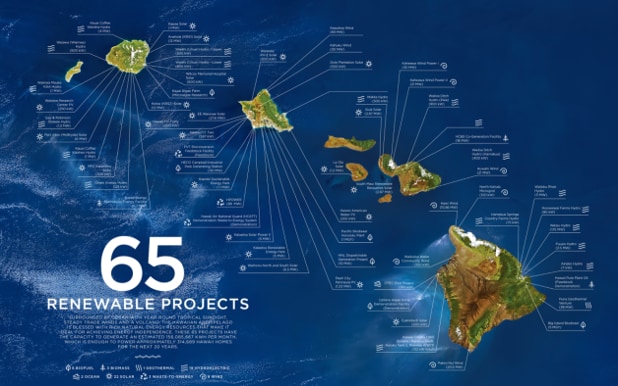How Hawaii plans to be the first US state to run entirely on clean energy

The Hawaiian government launched their clean energy initiative in 2008.
Image: REUTERS/Hugh Gentry
Stay up to date:
United States
Help us prevent the spread of disinformation
This article has been intentionally misrepresented on other websites that spread false information. Please read the piece yourself before sharing or commenting.
For more accurate information on this topic, see here.
It may have a reputation as an ecological paradise but Hawaii is also one of America’s most fossil fuel-dependent states. This is largely because of its isolated location in the Pacific Ocean – jet fuel accounts for more than half of all transportation fuel consumption in the state, according to the United States Energy Information Administration (EIA).
The state economy depends heavily on tourism and the military, and such is the demand from military installations and commercial airlines that jet fuel makes up a larger share of total petroleum consumption in Hawaii than in any other US state except Alaska.
To cut the state’s greenhouse gas emissions, the Hawaiian government launched the clean energy initiative in 2008, which pledges to establish new green credentials and aims to use 100% renewable electricity to power the entire state by 2045.
Having introduced ambitious renewables goals for power generation, Hawaii is now looking at cleaning up ground transportation, a major source of fossil fuel consumption.

In a significant move, four mayors from across the state have signed an agreement to run Hawaii’s public transport system using only clean energy by 2045.
Making the announcement aboard a traditional Hawaiian voyaging canoe, Maui mayor Alan Arakawa said: “The goals we are setting today are not only desirable, but attainable, and help send a message that Maui County and Hawaii are open for innovation to help ensure the greater health of our communities and the planet as a whole.”
President Donald Trump decided last year to withdraw the US from the Paris Agreement, which is dedicated to keeping global warming temperatures below 2C and if possible, under 1.5C.
Soon afterwards, Hawaii became the first state to turn the agreement into official policy, which led the island’s governor David Ige to say: “Climate change is real, regardless of what others may say.”
Hawaii’s clean energy credentials
Hawaii’s commitment to improving the environment is such that it is currently home to more than 60 clean energy projects, including nine wind farms, 19 hydroelectric facilities and 22 solar power plants.
According to the Hawaii State Energy Office, collectively these projects have the capacity to generate around 156 million kilowatt hours of energy per month, or enough to power 314,600 Hawaiian homes for the next 20 years.

The island of Kauai, which sits north-west of the Hawaiian capital of Honolulu, boasts over 15 of these projects, including a major solar farm created by Tesla and the Kauai Island Utility Cooperative.

The project is composed of 54,978 solar panels with 13 megawatts of solar generation capacity, and Tesla has also installed 272 Powerpack 2 battery systems to store the solar energy to use at night.
According to Tesla, the project is expected to reduce fossil fuel use by around 1.6 million gallons per year, with the system being turned on in phases.
Don't miss any update on this topic
Create a free account and access your personalized content collection with our latest publications and analyses.
License and Republishing
World Economic Forum articles may be republished in accordance with the Creative Commons Attribution-NonCommercial-NoDerivatives 4.0 International Public License, and in accordance with our Terms of Use.
The views expressed in this article are those of the author alone and not the World Economic Forum.
Related topics:
Forum Stories newsletter
Bringing you weekly curated insights and analysis on the global issues that matter.
More on Nature and BiodiversitySee all
Michael Donatti and Laura Fisher
July 3, 2025
Tim Lenton and Steve Smith
June 30, 2025
Susan Hu and Zhang Yuan
June 27, 2025
Allison Voss
June 25, 2025



